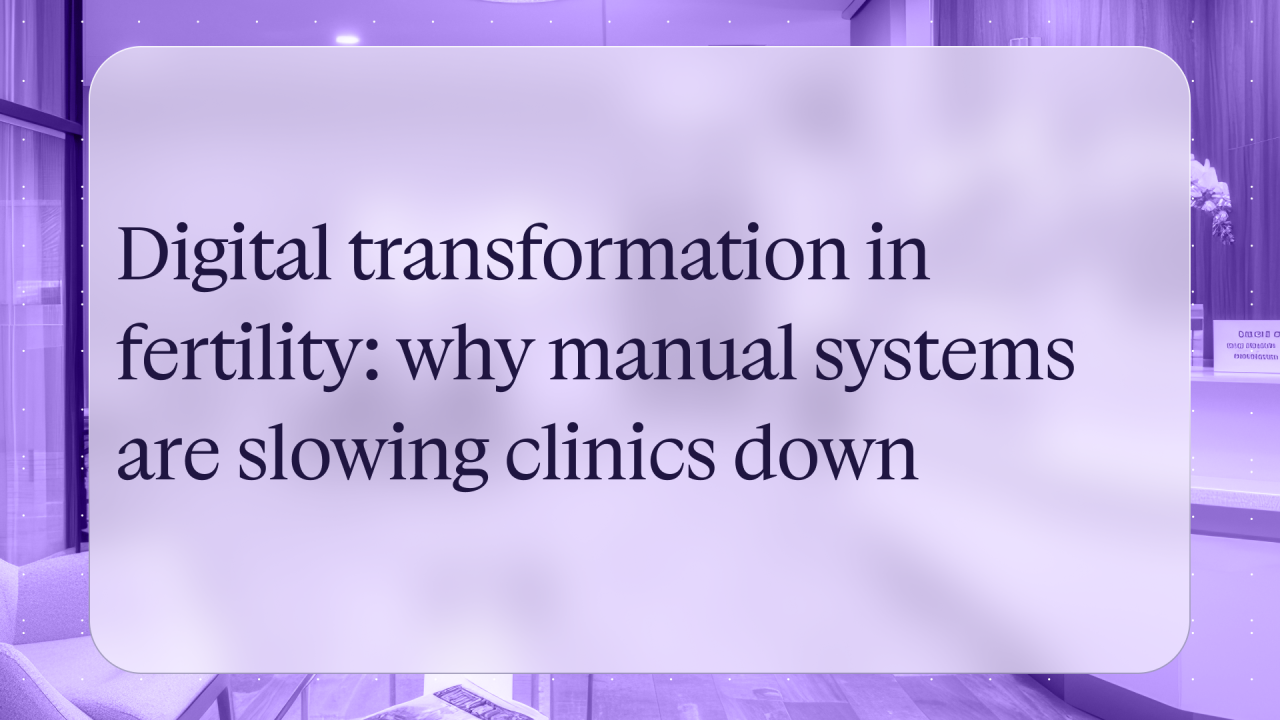Digital transformation in fertility: why manual systems are slowing clinics down

In the world of fertility care, precision matters. Timings are tight. Emotions run high. Every interaction, whether it’s booking an appointment or confirming a medication protocol carries real weight. Yet across many fertility clinics in the UK, the systems supporting this care are still stuck in the past.
Paper notes. Spreadsheet trackers. Post-it reminders on cluttered desks. It’s a familiar scene and one that’s more than just inefficient. It’s actively getting in the way of patient experience, staff wellbeing, and clinical outcomes.
So, what’s the real cost of sticking with manual systems?
1. Time Lost = Care Delayed
Let’s start with the obvious: manual systems take time.
Patient forms that have to be printed, filled in by hand, scanned, and uploaded. Internal messages scribbled down and passed between departments. Referral letters that sit in a physical tray until someone chases them.
These tasks chip away at clinical time. For a nurse or admin team already under pressure, this means less time supporting patients and more time chasing paperwork. It’s not uncommon for admin teams in mid-sized clinics to spend over 10 hours a week on manual comms and data entry alone.
That time isn’t just expensive, it’s a missed opportunity for care.
2. Patient Trust Erodes When Communication Breaks Down
Patients going through fertility treatment often feel overwhelmed. They want clear answers and timely support. But when their messages get lost in an inbox or appointment confirmations rely on a single person remembering to call, frustration builds.
According to a 2023 Fertility Network UK survey, 67% of patients said they felt “left in the dark” during parts of their IVF journey. Much of this comes down to inconsistent communication and unclear expectations.
Digital systems don’t replace human compassion, they ensure that the right information reaches the right person, at the right time. Automated updates, centralised messaging, and self-serve patient portals aren’t just conveniences- they’re trust-builders.
3. Manual Mistakes Can Undermine Clinical Decisions
Fertility treatment is complex and highly individualised. Small errors in timing, medication tracking, or lab scheduling can have big consequences.
Paper-based notes are more prone to error, duplication, and loss. In clinics where teams are growing or rotating frequently, relying on manual systems increases the risk of miscommunication. A file left on someone’s desk. A consent form not uploaded in time. A medication protocol missed in a shared spreadsheet.
Digitisation brings standardisation. It ensures key clinical information is captured, timestamped, and accessible, without relying on memory or legibility.
4. Operational Growth Is Almost Impossible Without Systems
As fertility clinics grow, whether adding new services, expanding to new sites, or partnering with third parties, the cracks in manual systems only widen.
Without a unified digital infrastructure, operational oversight becomes difficult. Clinic managers and COOs can’t easily track where delays are happening, how patients are moving through the system, or where resource bottlenecks sit.
This makes scaling not just difficult, but risky. Growth without infrastructure often leads to inconsistency in care, increased staff burnout, and lower patient satisfaction.
5. Staff Burnout Is Fuelled by Bad Systems
We often talk about burnout in healthcare in the context of workload. But just as important is the type of work.
When skilled professionals spend their days chasing paperwork, troubleshooting IT, or tracking patients across six different platforms, morale suffers. Teams feel reactive, not proactive. Talented nurses and admin staff become fixers of broken processes—not facilitators of care.
Digital transformation isn’t about replacing jobs. It’s about giving people the tools they need to do theirs well and with purpose.
So, what's the alternative?
Digital transformation doesn’t mean overnight overhaul. It means asking the right questions:
- Which manual tasks are costing us the most time or accuracy?
- Where are communication breakdowns affecting patient experience?
- What do our teams need to feel more in control and less reactive?
The best systems aren’t the flashiest. They’re the ones that work quietly, reliably, in the background. They support staff, reduce friction, and make care safer.
At Salve, we work with clinics to streamline workflows, reduce admin overhead, and bring patient engagement into the 21st century. But digital transformation isn’t just about what we offer- it’s about what clinics stand to gain when they stop letting paper slow them down.
Because when the system works better, everyone wins: the patient, the practitioner, and the business.

.png)



.jpg)





